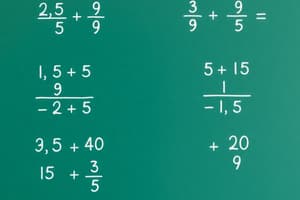Podcast
Questions and Answers
Which type of fraction represents a value less than 1?
Which type of fraction represents a value less than 1?
Which of the following is an example of an improper fraction?
Which of the following is an example of an improper fraction?
Which of the following is an example of a mixed number?
Which of the following is an example of a mixed number?
Which of the following statements correctly describes a unit fraction?
Which of the following statements correctly describes a unit fraction?
What type of fraction is 3/2?
What type of fraction is 3/2?
Which of the following fractions is equivalent to 1/2?
Which of the following fractions is equivalent to 1/2?
What is the result of converting the mixed number 2 1/3 into an improper fraction?
What is the result of converting the mixed number 2 1/3 into an improper fraction?
Which of the following fractions represents a value equal to 1?
Which of the following fractions represents a value equal to 1?
Flashcards
Proper Fractions
Proper Fractions
Fractions where the numerator is smaller than the denominator, e.g., 2/3.
Improper Fractions
Improper Fractions
Fractions where the numerator is greater than or equal to the denominator, e.g., 5/2.
Mixed Numbers
Mixed Numbers
A combination of a whole number and a proper fraction, e.g., 1 2/3.
Equivalent Fractions
Equivalent Fractions
Signup and view all the flashcards
Unit Fractions
Unit Fractions
Signup and view all the flashcards
Decimal Fractions
Decimal Fractions
Signup and view all the flashcards
Addition of Fractions
Addition of Fractions
Signup and view all the flashcards
Division of Fractions
Division of Fractions
Signup and view all the flashcards
Study Notes
Types of Fractions
- Proper Fractions: A fraction where the numerator is smaller than the denominator. Examples include 2/3, 5/8, and 1/10. These fractions represent values less than 1.
- Improper Fractions: A fraction where the numerator is greater than or equal to the denominator. Examples include 5/2, 7/4, and 12/12. These fractions represent values equal to or greater than 1.
- Mixed Numbers: A combination of a whole number and a proper fraction. Examples include 1 2/3, 2 5/8, and 3 1/4. Mixed numbers can be converted to improper fractions and vice versa.
Equivalent Fractions
- Equivalent fractions represent the same value but have different numerators and denominators. They are obtained by multiplying or dividing both the numerator and denominator by the same non-zero number. Examples include 1/2, 2/4, and 3/6.
Common Fractions
- Common fractions are fractions simplified to their lowest terms. This simplifies comparison and calculations.
Unit Fractions
- Unit fractions are fractions where the numerator is 1. Examples include 1/2, 1/3, and 1/4. They represent a portion of a whole.
Decimal Fractions
- Decimal fractions are fractions with denominators of 10, 100, 1000, and so on. They are expressed using a decimal point. For example, 0.5 is equivalent to 5/10 or 1/2.
Comparing Fractions
- Fractions can be compared using methods that involve finding a common denominator. This makes comparison easier. Comparing 1/2 and 2/3 requires finding a common denominator, such as 6.
Addition and Subtraction of Fractions
- To add or subtract fractions, they must first have a common denominator. Then, add or subtract the numerators while keeping the common denominator the same. For example, 1/4 + 3/4 = 4/4 = 1.
Multiplication of Fractions
- To multiply fractions, multiply the numerators together and the denominators together. For example, (3/4) * (2/5) = (3 * 2)/(4 * 5) = 6/20 = 3/10.
Division of Fractions
- To divide fractions, multiply the first fraction by the reciprocal of the second fraction. The reciprocal is obtained by swapping the numerator and denominator. For example, (3/4) ÷ (2/5) = (3/4) * (5/2) = 15/8.
Simplifying Fractions
- Simplify fractions by reducing them to their lowest terms. This involves removing common factors from both the numerator and denominator. For example, 4/8 simplifies to 1/2.
Studying That Suits You
Use AI to generate personalized quizzes and flashcards to suit your learning preferences.




